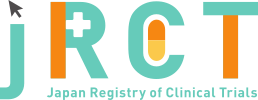臨床研究等提出・公開システム
|
Aug. 03, 2022 |
|
|
June. 18, 2024 |
|
|
jRCTs042220048 |
The digital intervention of a glycated albumin (GA) self-monitoring system for patients with type 2 diabetes: a randomized, open-label, non-intervention group controlled, single-center clinical study |
|
The digital intervention of a glycated albumin (GA) self-monitoring system for patients with type 2 diabetes |
|
Jan. 07, 2023 |
|
99 |
|
28.0% female and 72.0% male, age 63.2+-11.4 years, body weight 66.27+-13.68 kg, BMI 24.47 +-3.66 kg/m2, height 164.01+-9.96 cm, abdominal circumference 88.67+-10.26 cm, pulse rate 77.1+-11.2 bpm, systolic blood pressure 125.3+-12.4 mmHg, and diastolic blood pressure 72.6+-8.5 mmHg. In addition, 96.8% of the subjects were receiving drug therapy for diabetes, 57.0% diet therapy, 63.4% exercise therapy. 98.8% of subjects had complications including hypertension (52.7%), dyslipidemia (87.1%), hyperuricemia (5.4%), nerve disorder (2.2%), and diabetic retinopathy(5.4%) |
|
Of the 99 subjects who consented to the study, since one dropped out due to screening failure, a total of 98 subjects were randomly assigned. A total of 92 subjects (the Intervention group: 44, the nonIntervention group: 48) completed the study. |
|
One "medical device use site pain" was developed in one subject assigned to the intervention group. It was relieved after 8 days of onset, and recovery was confirmed after 39 days of onset. The same event did not occur during subsequent blood draws. |
|
Primary endpoint: (1) The change in GA value from baseline to last observation day showed a significant decrease in the intervention group compared to the nonintervention group. (2) The changes in calorie intake from baseline to last observation day showed a decrease in the intervention group compared to the non-intervention group, but there was no statistically significant difference between the two groups. (3) The change in physical activity (calorie consumption) from baseline to last observation day showed a significant decrease in the intervention group compared to the non-intervention group. Secondary endpoints: (1) The change in HbA1c from baseline to last observation day showed a significant decrease in the intervention group compared to the non-intervention group. (2) The change in body weight from baseline to last observation day showed a significant decrease in the intervention group compared to the nonintervention group. (3) The change in BMI from baseline to last observation day showed a significant decrease in the intervention group compared to the nonintervention group. (4) The change in abdominal circumference from baseline to last observation day showed a significant decrease in the intervention group compared to the nonintervention group. (5) The change in the total score of Self-efficacy scale for diabetes self-care from baseline to last observation day showed a significant decrease in the intervention group compared to the non-intervention group. (6) The changes in the total score of Exercise Self-efficacy scale for diabetes self-care from baseline to last observation day showed a decrease in the intervention group compared to the non-intervention group, but there was no statistically significant difference between the two groups. |
|
Patients with type 2 diabetes mellitus were studied to evaluate whether monitoring glycoalbumin (GA) levels through weekly self-monitoring of blood samples would motivate behavioral change toward drug therapy, diet, and exercise. Results showed that the intervention method in this study motivated behavioral change and significantly reduced GA, HbA1c, body weight, BMI, and abdominal circumference compared to the non-intervention group. |
|
May. 16, 2024 |
|
May. 16, 2024 |
|
https://link.springer.com/article/10.1007/s13300-024-01599-2 |
No |
|
(1) Case Report Form (paper): The principal investigator will keep the original and submit the PDF file to the Data Management Officer. (2) Questionnaires(paper): Research subjects shall submit to the investigators, and the investigators or research staff shall keep the original and submit the PDF file to the data management. (3) GA measurement results (electronic file): The GA test agency will submit the subject identification code, date of blood collection, and measurement results to the data management in an electronic file. (4) Data set for analysis and analysis report (electronic file): The data management prepares and submits the data set for analysis to the statistical analyst. The statistical analyst submits the report to the principal investigator. (5) Summary report (electronic file): Prepared and finalized under the supervision of the principal investigator. |
|
https://jrct.niph.go.jp/latest-detail/jRCTs042220048 |
Jinnouchi Hideaki |
||
Jinnouchi Hospital |
||
6-2-3, Kuhonji Chuo-ku, Kumamoto-shi, Kumamoto |
||
+81-96-363-0011 |
||
ct@jinnouchi.or.jp |
||
Yoshida Akira |
||
Jinnouchi Hospital |
||
6-2-3, Kuhonji Chuo-ku, Kumamoto-shi, Kumamoto |
||
+81-96-363-0011 |
||
ct@jinnouchi.or.jp |
Complete |
Aug. 03, 2022 |
||
| 100 | ||
Interventional |
||
randomized controlled trial |
||
open(masking not used) |
||
no treatment control/standard of care control |
||
parallel assignment |
||
treatment purpose |
||
(1) Patients who meet the diagnostic criteria for type 2 diabetes mellitus of the Japan Diabetes Society |
||
(1) Patients on insulin therapy |
||
| 20age old over | ||
| No limit | ||
Both |
||
type 2 diabetes mellitus |
||
Study subjects assigned to the intervention group will have GA measured once a week and will record daily behavioral assessments of treatment goals on the application. |
||
type 2 diabetes mellitus |
||
digital intervention, glycated albumin, type 2 diabetes mellitus, clinical study, self-monitoring |
||
1) Glycoalbumin (GA) |
||
1) HbA1c |
||
| Provigate, Inc. | |
| Applicable |
| AMED: Japan Agency for Medical Research and Development | |
| Not applicable |
| Fujita Health University Certified Review Board | |
| 1-98 Dengakugakubo, Kutsukake-cho, Toyoake, Aichi | |
+81-562-93-2865 |
|
| crb-f@fujita-hu.ac.jp | |
| Approval | |
July. 27, 2022 |
none |
